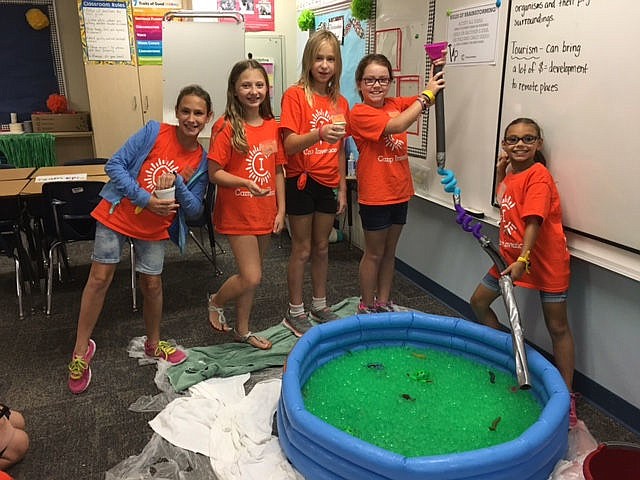- July 26, 2024
-
-
Loading

Loading

Building solar bugs, designing theme parks, working with binary codes, destroying DVD players and making pinball machines were all part of the hands-on curriculum at Windermere Elementary School’s Camp Invention.
“The whole experience sparked a new curiosity about how things work. We have even taken apart several things around our house since the camp,” said 9-year-old Tyler Bolivar and 6-year-old Kayla Bolivar, two of the 89 campers who participated this summer.
Camp Invention, a four-day science camp based on STEM activities, was held June 20 to 23. The camp is sponsored by the National Inventors Hall of Fame and is a national program hosted in schools around the country.
The summer camp encouraged first- through eighth-grade students to think outside the box by engaging in four modules: I Can Invent: Maker Studio; The Lab: Where Pigs Fly; Crickobot; and Epic Park.
In Crickobot, the campers were urged to build crickets powered by solar energy out of recycled items.
“They looked at the crickets and kind of looked at each part of the cricket, like its exoskeleton and how they could create something (similar), … and they just took everyday recycled items, (such as) paper tubes and bottle caps and duct tape and kind of created their own parts of the Crickobot,” said Lynn Tidmus, the director of the camp and a science teacher at Windermere Elementary. “It was really cool. They learned about the science of how the cricket works.”
In the Maker Studio, the campers were allowed to disassemble machines and use the individual pieces to build new machines of their own choosing.
“They brought in DVD players or clocks or any kind of machinery, and they took it apart,” Tidmus said. “I mean, they literally took it apart using screwdrivers, pliers, wire cutters – they just took apart the innards of these machines. And then, on the third or fourth day of the camp, they used what they took apart to create new machines and new inventions. It was fabulous.”
Using the individual parts from the dismantled clocks and DVD players, the campers built all sorts of machines, including pinball machines, confetti shooters, doll houses and helicopters.
“I loved destroying old machines and then rebuilding them into new inventions,” 11-year-old Manuela Conclaves said. “Our group built a robot on a skateboard. In Crickobot, my best invention was creating cricket wings that mimicked the real sound that crickets make with their wings.”
Eight-year-old Hannah Kim liked the Maker Studio best because it challenged her to “invent something out of real stuff.”
In “The Lab: Where Pigs Can Fly” module, the students did more experiment-based projects, but also worked with binary codes to make necklaces and write messages using the coding.
Given the fun the kids had and the opportunity it presented to “dive deeper into the ‘why’ of things,” Tidmus hopes to host the camp again next summer.
“I really hope they come out with a sense of empowerment – that anything they look at, they can explore and discover and go deeper into the science of it,” Tidmus said. “That’s what I really want them to take from it — that science is fun. It’s not intimidating, and they can have fun learning.”
---
Contact Gabby Baquero at [email protected].